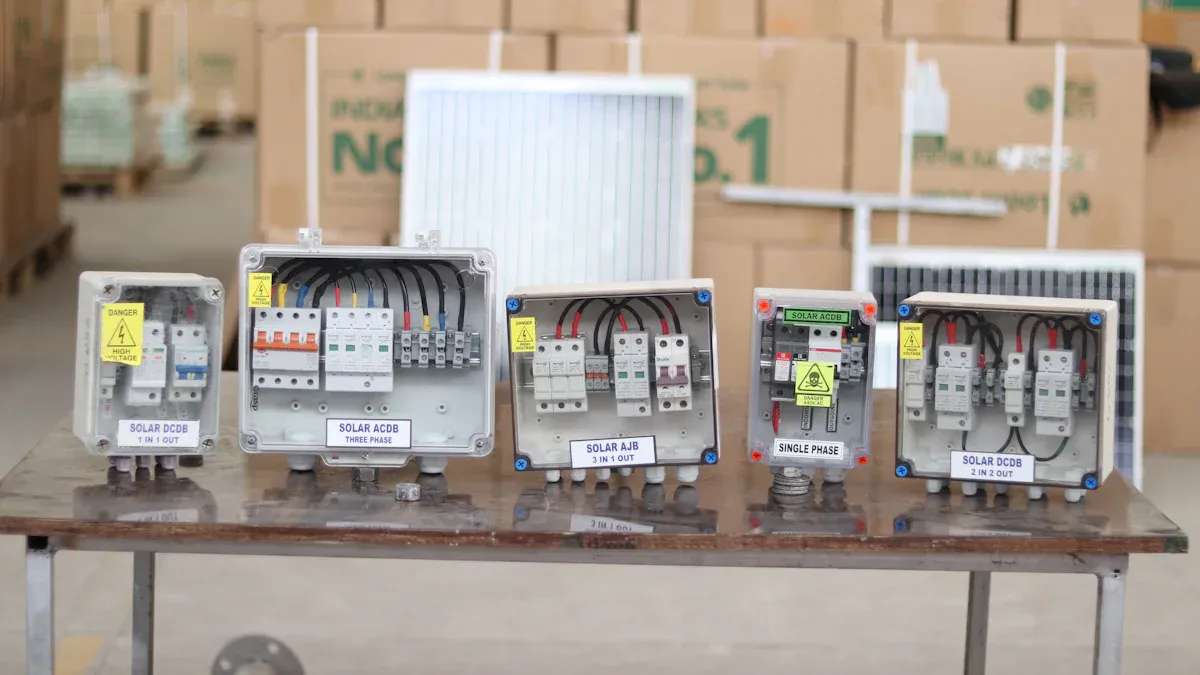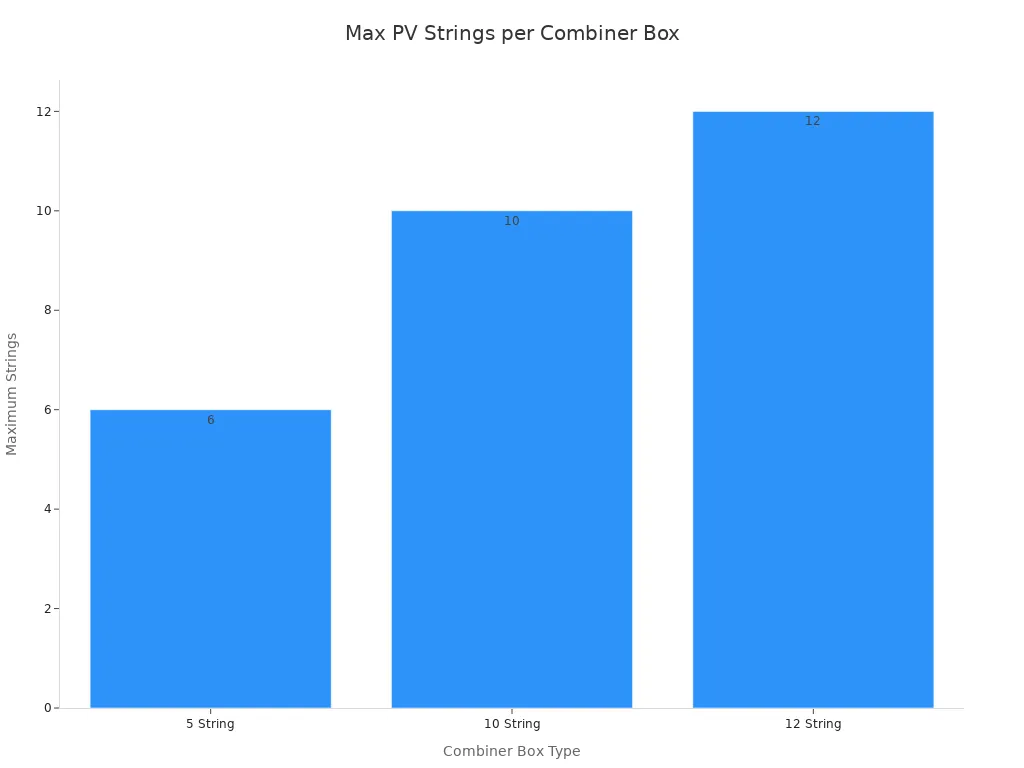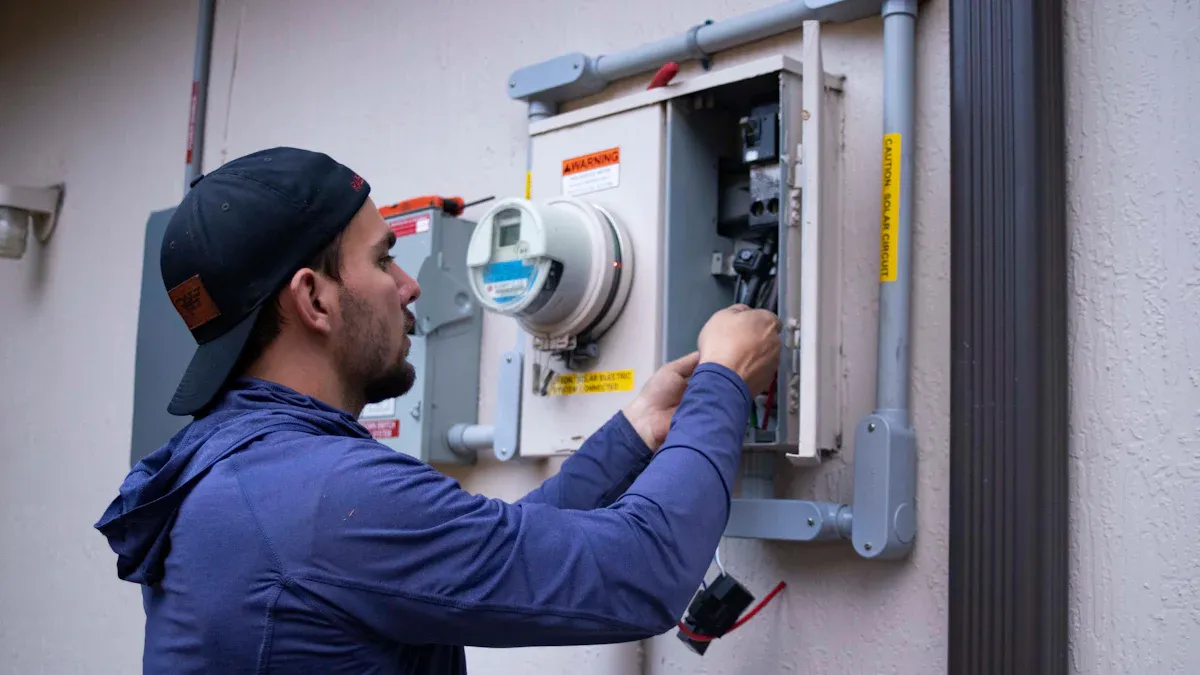You need to count your solar strings. You also need to check how much power each solar combiner box can take. Look at how your system is set up. This helps you know how many boxes you need. A solar combiner box takes power from many solar panel strings. It sends the power to your inverter. Most small homes with three or fewer strings may not need a combiner box. Safety is very important. Check the table below for common mistakes:
| Mistake Description | Safety Incident |
|---|---|
| Picking a combiner box that does not match the system’s voltage and current | Wires can lose insulation, spark, and stop working |
| Using wires that are too small | Voltage can drop, wires can get hot, and fires can start |
| Not grounding the system right | People can get shocked or ground faults can go unnoticed |
| Leaving out surge protection devices | Lightning or grid problems can damage your system |
Think about how your system works now. Also, think about if you want to add more later before you choose.
Key Takeaways
- Count your solar strings first. This helps you know if you need a combiner box. If you have more than three strings, you need one. It keeps your system safe and working well.
- Check the voltage and current ratings of your combiner box. Pick a box that matches your system’s needs. This stops overheating and keeps your equipment from breaking.
- Plan your system layout with care. A good layout makes fixing things easier. It also lets you add more parts later without big changes.
- Look for important safety features in your combiner box. Surge protection and overcurrent protection are very important. They help stop damage and keep everyone safe.
- Ask a professional for help with hard systems. An expert can help you avoid mistakes. They make sure your solar setup is safe and follows all rules.
Key Factors for Solar Combiner Box Selection

Number of PV Strings
When you set up your solar system, first count your PV strings. A PV string is a group of solar panels joined together. If you have more than three strings, you will need a pv combiner box. This box helps you safely collect power from all the strings.
Here is a table that shows how many strings each combiner box can handle:
| Combiner Box Type | Maximum Strings | Maximum Input Current per String | Maximum Output Current |
|---|---|---|---|
| 5 String | 6 | 15A | 100A |
| 10 String | 10 | 16A | 160A |
| 12 String | 12 | 10-15A | 20A |

If you connect too many strings to one box, it can get overloaded. This can make your system unsafe and not work as well. Sometimes, one string might not work right. If that happens, your whole system can lose power. You want every string to work well, so match the number of strings to the right box.
Tip: If you want to add more solar panels later, pick a pv combiner box with extra room for more strings.
Input Capacity and Ratings
You should check the input capacity and ratings of your pv combiner box. This means looking at how much voltage and current the box can handle. Most boxes for homes and businesses have voltage ratings like 1000V or 1500V DC. The current rating shows how much power each string can send to the box.
- Most solar combiner boxes have voltage ratings of 1000V or 1500V DC.
- Current ratings let the box handle several strings at once.
If you choose a box that cannot handle your system’s voltage or current, you could break your equipment. For big solar systems, input capacity limits decide how many strings you can put in one box. The right box keeps your system safe and working well.
- Input capacity limits tell you how many strings you can connect.
- These limits also affect the most current the box can take.
- Picking the right box keeps your system safe and working.
Here are some safety features you should look for in a solar combiner box:
| Safety Feature | Description |
|---|---|
| Surge Protection | Protects the system from power surges and lightning, stopping damage to parts. |
| Overcurrent Protection | Uses fuses or circuit breakers to stop overloads and fires. |
| DC Isolation | Lets you safely turn off DC circuits during repairs, stopping electric shock. |
Note: Always make sure your pv combiner box meets safety rules like UL 1741, UL 67, and NEC 690.9. This helps you pass checks and keeps your system safe.
System Layout
How you set up your solar system changes how many pv combiner boxes you need. A good layout makes it easy to reach your boxes for repairs or upgrades. If you put your boxes where they are hard to reach, fixing them will be tough.
- Plan your layout so you can reach each pv combiner box easily.
- Try not to use long wires. Long wires can lower voltage and make repairs harder.
- Leave enough space for workers to fix the boxes.
- A smart layout lets you add more panels or strings later without starting over.
Regular checks by a solar expert help you find problems early. If you design your system well, you can fix issues faster and even grow your system later.
Here are some important standards you should know:
| Standard | Description |
|---|---|
| UL 1741 | Inverters, combiners, and PV system equipment |
| UL 67 | Panelboards and enclosures |
| UL 508A | Industrial control panels |
| UL 489 | Molded-case circuit breakers |
| NEC 690.9 | Overcurrent protection |
| NEC 690.15 | Disconnecting means |
| NEC 690.17 | Switch ratings for DC circuits |
| NEC 705 | Interconnection to the grid |
Remember: UL certification and NEC rules are not just for passing checks. They keep your solar system safe and working well.
How to Calculate PV Combiner Box Needs

Step-by-Step Guide
You want to know what steps to take when figuring out how many pv combiner boxes you need. Here’s a simple guide to help you get started:
- Count Your PV Strings
Start by counting how many strings of solar panels you have. Each string is a group of panels connected together. The total number of strings tells you what size pv combiner box you need. - Check the Ratings of Your Panels
Look at the rated current and voltage for each panel. This helps you pick the right pv combiner box and the right fuses. - Choose the Right Combiner Box Size
Find a pv combiner box that can handle all your strings. For example, if you have 10 strings, you need a box with at least 10 inputs. - Calculate Cable Size
Figure out the current for each string. Multiply the panel current by 1.25 for safety. Pick a cable size that can handle this current. - Pick the Right Fuses
Use fuses that are rated for at least 1.25 times the panel’s short-circuit current. You need one fuse for each string. - Select a DC Circuit Breaker
Add up the current from all strings. Multiply by 1.25. Choose a breaker that matches this value and is rated for DC use. - Add Surge Protection
Make sure your pv combiner box has a surge protection device. The voltage rating should be higher than your system’s maximum voltage.
Here’s a table showing what factors you need to check when picking a pv combiner box:
| Factor | Description |
|---|---|
| Number of Panels | More panels mean you need a bigger box with higher voltage ratings. |
| Rated Current of Panels | Higher current needs bigger fuses and cables. |
| Junction Terminal Importance | Good terminals make wiring easier and safer. |
| Inside Component Quality | High-quality parts keep your system safe and reliable. |
| Anti-reverse Diode | Stops current from flowing the wrong way and protects your inverter. |
| Enclosure Types | Different materials affect how long your box lasts and how well it keeps out water. |
Tip: Always double-check your wiring. Small mistakes inside a pv combiner box can cause big problems, like hot spots or tripped breakers.
Example Calculation
Let’s look at what you would do for a 10-string solar system. This example shows what steps you need to follow:
- Count Your Strings
You have 10 strings. You need a pv combiner box with at least 10 inputs. - Calculate Cable Size
Each string gives 10 amps. Multiply by 1.25 for safety. That’s 12.5 amps per string. Use a 4 mm² PV cable. - Find Output Current
10 strings × 10 amps = 100 amps. Multiply by 1.25 for safety. That’s 125 amps. Pick a cable that can handle this. - Pick Fuses
Each fuse should be at least 1.25 × Isc (short-circuit current). For 10 amps, that’s 12.5 amps. Use 16A or 32A fuses, one for each string. - Choose a DC Circuit Breaker
The output current is 100 amps. Multiply by 1.25. That’s 125 amps. Use a DC breaker rated for 160A. - Add Surge Protection
If your system’s max voltage is 400V, pick a surge protector rated for at least 600V or 1000V. Make sure it can handle a surge of 40 kA.
Here’s what a calculation might look like in code form:
Number of Strings = 10
Per String Current = 10A
Safety Factor = 1.25
Cable Size per String = Per String Current × Safety Factor = 12.5A
Total Output Current = Number of Strings × Per String Current = 100A
Output Cable Size = Total Output Current × Safety Factor = 125A
Fuse Size per String = Per String Current × Safety Factor = 12.5A
Breaker Size = Total Output Current × Safety Factor = 125A (choose next standard size up)
Note: If you plan to expand your solar system later, pick a pv combiner box with extra inputs. This makes upgrades much easier.
What Mistakes Should You Watch Out For?
- Small wiring errors inside a pv combiner box can cause big losses.
- These mistakes can lead to hot spots, nuisance trips, and hard-to-find faults.
- Always use high-quality parts and double-check your work.
You now know what steps to take and what to check when picking a pv combiner box for your solar setup. This helps you avoid common mistakes and keeps your system safe.
Types of Combiner Boxes
When you look at solar systems, you’ll see several types of combiner boxes. Each type fits a different need, so it’s important to know what’s out there before you choose.
Residential vs. Commercial
You’ll find that the types of combiner boxes used in homes are not always the same as those in big commercial projects. In small residential solar setups, you might not need a combiner box at all. If your system has only one or two strings, you can connect them straight to your inverter. This keeps things simple and saves money.
For bigger homes or commercial buildings, you’ll likely need a combiner box. Commercial systems often use more strings and higher voltages. They need boxes that can handle more power and offer extra safety features.
Here’s a quick look at the main types of combiner boxes and where you might use them:
| Type of Combiner Box | Description |
|---|---|
| Standard Combiner Boxes | Simple and affordable, great for basic setups. |
| Integrated Combiner Boxes | Come with built-in parts, so you spend less time on installation. |
| Smart Combiner Boxes | Let you monitor your system and spot problems fast. |
| AC Combiner Boxes | Used in systems that send AC power, common in big commercial jobs. |
| DC Combiner Boxes | Handle high voltages, perfect for large solar farms. |
Tip: Most small homes with fewer than three strings do not need a solar combiner box. You can keep your system simple if you have just one or two strings.
Choosing the Right Type
Picking the right combiner box depends on your system’s size and needs. You want a box that matches your inverter and panels. Make sure it can handle your system’s voltage and current. Look for safety features like fuses, surge protectors, and circuit breakers. If you want to track your solar system’s performance, a smart combiner box can help.
Here are some things to check when you choose:
- Count your strings and panels to size the box right.
- Check voltage and current ratings.
- Look for protection features to keep your system safe.
- Make sure you can reach the box for repairs.
- Think about future upgrades. Pick a box that lets you add more panels later.
If you plan ahead, you’ll save time and money. The right combiner box keeps your solar system safe and easy to manage.
Practical Tips and Placement
Selection Tips
When you pick equipment for your solar setup, you want to make smart choices. Here’s what you should look for:
- Choose a weatherproof enclosure with at least an IP65 rating. This keeps out rain, dust, and sun.
- Make sure the box has overcurrent protection, like fuses or circuit breakers. These stop damage from too much current.
- Look for surge protection. This feature shields your system from voltage spikes.
- Pick a box that lets you reach connections and fuses easily. You want maintenance to be simple.
- Think about where you will install the box. The material and design should match your environment for long-lasting use.
Tip: A good box makes your solar system safer and easier to manage.
Placement Considerations
Where you put your equipment matters for both safety and performance. Here are some things to keep in mind:
- Avoid spots with too much sunlight, moisture, or dirt.
- Place the box close to your solar panels, but not where it gets direct sun or water.
- Make sure you can reach the box for checks and repairs.
- Mount the box securely so wind or animals cannot move it.
- Use high-quality wires and connectors for strong, safe connections.
Here’s a table showing what each function does for your system:
| Function | Description |
|---|---|
| Electrical Distribution | Collects and sends power from many PV strings. |
| Overcurrent Protection | Stops too much current from hurting your equipment or causing danger. |
| Surge Protection | Lowers the risk from voltage spikes, like lightning or grid problems. |
| Monitoring and Control | Gives you real-time data about your system’s performance. |
Note: Good placement helps your solar system work better and last longer.
When to Consult a Pro
Sometimes, you need expert help. Here’s what to watch for:
- If you have a large or complex solar setup.
- When you are not sure about voltage, current, or safety features.
- If you want to make sure your system meets all codes and standards.
A professional knows how to choose the right box, place it safely, and connect everything the right way. Look for someone with technical knowledge and certifications, like NABCEP PV Installer. They will make sure your equipment is sealed, dustproof, and safe for your needs.
Callout: A pro can help you avoid costly mistakes and keep your solar system running smoothly.
You now know what determines the number of combiner boxes for your solar panel systems. The right choice depends on how many strings you have, the box’s capacity, and your solar power system layout. Check out this quick guide:
| Number of Solar Strings | Do You Need a Combiner Box? |
|---|---|
| 1 | Not needed |
| 2-3 | Suggested |
| More than 3 | Required for safety and efficiency |
Large solar setups often use advanced safety features and can boost power output, especially in low light. Even if your system is small, always focus on safety and follow the rules. For big or tricky solar projects, talk to a pro. Use these tips as your starting point.
FAQ
What is a solar combiner box used for?
A solar combiner box gathers power from several solar panel strings. It sends that power to your inverter. You use it to keep your system safe and organized.
What happens if you use the wrong combiner box?
If you pick the wrong box, your system can overheat or fail. You might see blown fuses or even fire risks. Always match the box to your system’s voltage and current.
What safety features should a combiner box have?
Look for surge protection, overcurrent protection, and DC isolation. These features help prevent shocks, fires, and damage from lightning. They keep your solar setup safe.
What size combiner box do you need?
You need a box that matches your number of PV strings. Check the voltage and current ratings. Pick a box with extra space if you plan to add more panels later.
What is the difference between residential and commercial combiner boxes?
Residential boxes handle fewer strings and lower voltages. Commercial boxes work with more strings and higher power. You pick the type based on your system’s size and needs.
See also
DC 1000V 6 in 2 Out PV Combiner Box
What is string solar inverter and how does it work
Inverter SPD vs Standard Surge Protector: What’s the Difference?
How to Wire Multiple Solar Panels into a Combiner Box Safely
Why Your Solar Energy Setup Requires a Combiner Box



